Intense competition among healthcare providers and increased pressure to continually improve the quality of food and services while containing and reducing costs have long been the challenges facing healthcare foodservice operators. So what’s new? The new normal is exponentially more intensively competitive with unprecedented pressure on healthcare foodservice operators to be at the top of their games.
 The list of challenges is longer and more complex than ever. It includes, but is not limited to, mergers and acquisitions of healthcare systems continuing on enormous scales, questions looming about the Affordable Care Act, how to prevent healthcare costs from rising above 18 percent of the gross domestic product, workforce shortages, increases in the minimum wage, a transition from volume- to value-based care, and meeting the needs of increasingly sophisticated and discerning patients and retail customers. It’s not hard to see why most healthcare foodservice providers feel a sense of anxiety as they come to grips with the new normal.
The list of challenges is longer and more complex than ever. It includes, but is not limited to, mergers and acquisitions of healthcare systems continuing on enormous scales, questions looming about the Affordable Care Act, how to prevent healthcare costs from rising above 18 percent of the gross domestic product, workforce shortages, increases in the minimum wage, a transition from volume- to value-based care, and meeting the needs of increasingly sophisticated and discerning patients and retail customers. It’s not hard to see why most healthcare foodservice providers feel a sense of anxiety as they come to grips with the new normal.
Rather than allowing the anxiety to feed a sense of resignation, healthcare foodservice operators dig deeper into their creative pockets to respond to the needs of countless constituencies — administrators, medical and administrative staff, patients, visitors, community members, purchasing groups, the government, foodservice employees and competitors, to name a few. Here, we take a look at a few of the many game-changing solutions operators continue to leverage in response to the challenges of today’s heated environment.
Competition Thrives and Cultures Change
“The biggest issue both worldwide and in the U.S. continues to be cost. All other trends stem from the cost factor, including access to care, advances in care (especially new drugs), accountable care/alternative payment models and digital consumer engagement,” says Mitch Morris, MD, vice chairman and U.S./global healthcare providers leader for Deloitte Consulting LLP. Morris made these remarks in the report “2016 Healthcare Providers Industry Outlook,” which is part of a larger report, “2016 Global Healthcare Sector Outlook.” In 2015, according to Deloitte’s report, 50 percent of current health systems were headed toward consolidation in the next decade.
“The effort to consolidate is unabated in regional and national healthcare systems,” says Paul Hysen, principal for The Hysen Group, a Northville, Mich.-based foodservice consulting firm. “What started out as thousands of individual entities is becoming a handful. Everyone’s looking for economies of scale and synergies. Directors will have multiple units to manage and provide services for ambulatory and other specialty centers as well as the main critical access hospitals. Competition for capital dollars is fierce, and years may pass from the master planning stages until completion. Foodservice directors must realize the pressure is on.”
With the increased competition comes significant financial concerns. “Hospitals must find cost reductions to offset initial reductions in Medicare and Medicaid payments. There will be serious implications for budgets due to reclassification of an FTE as working 30 hours a week and penalties for lower satisfaction scores and readmissions. In addition, they need to earn rewards for health and wellness,” says Nashville-based Glenn Schirg, MS, BS, senior associate, Kaizen Foodservice Planning & Design.
“We’ll continue to see pressure on healthcare food and nutrition departments to find the best balance for the three performance indicators: the budget and use of resources; patient satisfaction as determined by surveys from HCAHPS, Press Ganey and National Research Corporation; and productivity measured by benchmarking data,” says foodservice consultant Betty Perez, RD, DHCFA, of Suffern, N.Y.
The merging of organizations brings with it another challenge: blending the cultures from each entity into one cohesive unit. That’s the challenge Robert Wood Johnson Health System and Barnabas Health System face in the wake of their merger, which was announced in April. The two will now go to market as RWJBarnabas Health, the 15th-largest healthcare organization in the country. “One of the most challenging aspects of mergers is merging cultures, including those in foodservice and especially if one is self-op and another is contracted,” says Tony Almeida, director of food and nutrition, Robert Wood Johnson University Hospital (RWJUH), Brunswick, N.J.
The Patient Reigns: Room Service Amalgams
The number of hospitals offering room service and meals on demand continues to increase as administrators look to improve patient satisfaction and reduce food waste. For room service to be successful, it must also be efficient and cost-effective. Many factors contribute to the viability of room service, including foodservice department size, accessibility to dedicated elevators, distance between the kitchen and patient beds, internal production methods, use of technology, staffing structure and division of responsibility.
Most important, the selected room service model must be right for the facility. For some departments, a bedside order/spoken menu, in which a hostess visits with patients and marks up a printed copy of a menu or helps patients place orders by phone, tablet or console, works best. For others, allowing patients themselves to place orders by phone, tablet or console to a call center is preferable. “Another choice is whether to offer a large restaurant-style menu or a limited à la carte menu with some good comfort foods always available,” says Georgie Shockey, president, Ruck-Shockey Associates, Inc., The Woodlands, Texas.
Many foodservice departments now prefer a hybrid system for patients requiring different types of care. “The balance of technology and staff are what drive the spectrum of meal delivery offerings,” Shockey says. “Each facility is driving outcomes to take advantage of their resources and mitigate challenges, so this area has more elasticity now than it did 10 years ago.”
Regardless of which system a hospital chooses, enhancing patient satisfaction remains the main force driving the decision. “Patient satisfaction is linked to patients having a say in how they are treated and served,” says Schirg. “Studies prove that hospitals can impact satisfaction scores with the overall experience of the hospital stay.”
Patients do not rate foodservice on Hospital Consumer Assessment of Healthcare Providers and Systems (HCAHPS) surveys, which measure their perspectives of hospital care. HCAHPS scores do, though, play a role in determining whether a hospital or medical center receives Medicare reimbursement. And how patients feel about the food and foodservice can affect how they rate other services. Press Ganey and internally developed surveys ask patients about their satisfaction with food and foodservice and are used in many hospitals.
“We’ve had room service since 2003, and I highly recommend it,” Almeida says. “We had to add FTEs, but we started from scratch building the room service program. And we’ve grown. We started with 450 patients, and now we have 650 to serve. For us, room service is worth the cost because it helps us keep patient satisfaction scores high.”
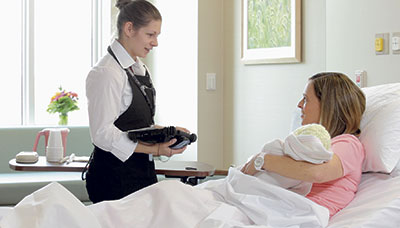 Chester County Hospital‘s Bedside Bistro program is based on relationships and accountability.Within 30 minutes of reaching their room at the 220-bed Chester County Hospital in West Chester, Pa., which is part of the University of Pennsylvania Health System, patients meet with a hospitality associate. The associate reviews the menu with the patient and explains the ordering system. “The Bedside Bistro program was implemented to compete with room service,” says Scott Greenley, director of nutrition services, Chester County Hospital. “It is a system based on relationships and accountability. A relationship is established with patients when a hospitality associate is assigned to certain units and works a 10.5-hour day serving all three meals and takes care of all foodservice needs, including floor stocks and late trays. This system stresses accountability because the associate is responsible for all the foodservice needs. This is the same for the nursing team.”
Chester County Hospital‘s Bedside Bistro program is based on relationships and accountability.Within 30 minutes of reaching their room at the 220-bed Chester County Hospital in West Chester, Pa., which is part of the University of Pennsylvania Health System, patients meet with a hospitality associate. The associate reviews the menu with the patient and explains the ordering system. “The Bedside Bistro program was implemented to compete with room service,” says Scott Greenley, director of nutrition services, Chester County Hospital. “It is a system based on relationships and accountability. A relationship is established with patients when a hospitality associate is assigned to certain units and works a 10.5-hour day serving all three meals and takes care of all foodservice needs, including floor stocks and late trays. This system stresses accountability because the associate is responsible for all the foodservice needs. This is the same for the nursing team.”
In the hours leading up to meal service, an associate uses a laptop to take patient meal orders. The customized diet office system edits menu selections for diets and allergies for each patient. “It also calculates the carbohydrates of menu items selected for patients on carb-controlled diets,” adds Greenley.
Another service Greenley and his team added in collaboration with the Chester County Hospital Interpreter Services team is a Spanish menu for the hospital’s large number of Spanish-speaking patients. “The menu has the same appearance of our regular patient menu,” Greenley says. “And all items are listed in Spanish and English for ease of translation when the hospitality associate takes bedside orders.”
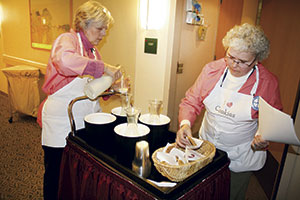 Volunteers assemble baskets of freshly baked cookies and cold milk to deliver to patients and visitors.Also perking up service, Chester County Hospital Services volunteers assemble baskets of freshly baked cookies and serve these with cold milk to patients and visitors in waiting rooms. “This hospitality gesture spreads good wishes,” Greenley says.
Volunteers assemble baskets of freshly baked cookies and cold milk to deliver to patients and visitors.Also perking up service, Chester County Hospital Services volunteers assemble baskets of freshly baked cookies and serve these with cold milk to patients and visitors in waiting rooms. “This hospitality gesture spreads good wishes,” Greenley says.
At the 160-bed Hendricks Regional Health hospital in Danville, Ind., hosts use tablets to take patients’ orders bedside. Prior to implementing this system, patients would phone their orders in to a two-person call center. As a result of this hybrid approach, now one person can staff the call center while the other person meets with the patients face-to-face.
Recidivism continues to top the list of major concerns for hospitals. If a patient comes back to the hospital within 30 days with the same problem, the hospital doesn’t receive reimbursement. Therefore, concern about patients’ state of nutritional health when they leave the hospital becomes as equally important as satisfaction with the quality of food and service. As a result, many foodservice departments now play an active role in helping patients after they leave the hospital.
“Some hospitals are actively involving pharmacy and nursing to work with patients during the first 30 days they leave the hospital to be sure they are taking their medicine,” says Martha Rardin, MSM, RD, CD, FAND, director of nutrition and dietetics at Hendricks Regional Health. “Nutrition also becomes involved because many people who are readmitted aren’t eating properly, either. So much of the recidivism depends on whether discharged patients have anyone taking care of them when they leave. Some hospitals are acquiring rehabilitation and long-term care facilities for patients to stay while they recover. The cost of care here is much less expensive. The cost of a readmission to a hospital can be $80,000 or more, depending on the hospital’s location.”
At the 520-bed Pennsylvania Hospital in Philadelphia, patient education continues to generate satisfaction. “All food items that contain carbohydrates (COH) are listed by their COH content so patients can learn which foods contain carbohydrates,” says Carolyn Tobin, director of food and nutrition and environmental services. “A footnote is added to the bottom of all the menus with a recommended amount of COH per meal.”
All food allergies are communicated to the foodservice staff via a purple food allergy tag that attaches to the patients’ menus. “Their menus are stamped for inspection,” Tobin says. “Any patient tray with a food allergy is built with a purple placemat. All patient meal trays that have allergy-sensitive foods are inspected by the supervisor, who puts his/her initials on the patients’ menus.” When a host delivers patient trays with allergy-sensitive foods, the host is scripted to say to the patient, “I understand you have a food allergy. Would you like to inspect the tray with me to ensure it is safe for you to eat?”
As an extra touch from Pennsylvania Hospital’s foodservice department, in the evenings, all medical, surgery and maternity patients are offered an evening snack from a snack cart.
Embarking on a Retail Culinary Experience
Healthcare foodservice has made huge strides in improving food quality and responding to customer requests for contemporary menu items and service choices. Retail operations invite customers in for an experience rather than just a meal. “Operators must stay attuned to their customers, and many of those customers are coming out of colleges, which have wonderful, sophisticated dining programs. So expectations are very high for retail operations in hospitals, outpatient clinics and ambulatory centers,” Hysen says.
Operators have tall orders to fill customers’ expectations. Customers want to explore the origins of foods and tastes and express their creative side through flavor combinations on menu selections, Shockey says. “Customers also want to be entertained with a ‘story’ about the food or ingredient or place they are dining and be educated about the products, ingredients and sources of food.”
“Healthcare foodservice trends include increased use of local food items, menu offerings that embrace more ethnic diversity, moving toward scratch cooking by using components that are combined just before service, requests for more healthy food options, and smaller portions and smaller plates,” says foodservice consultant Char Norton, MS, RDN, LD, FADA, FAND, FFCSI, based in Plattsburg, Mo.
“There is more focus on healthy menus but also spicier menu items and more flavorful items with spices,” says Mary Spicer, an independent foodservice consultant in Denton, Texas. “Chefs on staff bring culinary expertise and train colleagues.”
 RWJ Live, a themed dining station at Robert Wood Johnson University Hospital, features menus created by Executive Chef Timothy Gee, CEC.At RWJUH, hiring chefs has long been a highlighted feature of the food and nutrition services department. “The quality of food has changed significantly since we started hiring chefs, and their talent allows us to continuously improve our offerings,” says Almeida.
RWJ Live, a themed dining station at Robert Wood Johnson University Hospital, features menus created by Executive Chef Timothy Gee, CEC.At RWJUH, hiring chefs has long been a highlighted feature of the food and nutrition services department. “The quality of food has changed significantly since we started hiring chefs, and their talent allows us to continuously improve our offerings,” says Almeida.
For example, the RWJUH café features something for every type of customer, including a 24-foot-long salad bar, deli and grill stations, and stations offering exciting concepts such as carnival-themed foods, Jamaican jerk chicken and NYC-style halal chicken and rice. One of the most popular additions is RWJ Live, a station with themes and menus created by executive chef Timothy Gee, CEC. Changing weekly, themes include made-to-order favorites such as burritos and tacos, a Greek festival with gyros, oriental chicken salad, and personal flatbread gourmet pizza. One themed event allows customers to choose from a selection of made-to-order dim sum dumplings, which is accompanied by a healthy salad with kale and brussels sprouts. “Adding excitement to dining options increases patient satisfaction and our guest services,” Gee says.
“We started this two and a half years ago,” Almeida adds. “The themed stations replaced a pizza station and helped boost sales by $400,000 in 2014 and 2015. We need two people manning this station, and we all jump in to help as needed.”
Replacing equipment is also key to this department’s success. “Equipment gets beat up with use, so every few years, we replace grills, broilers and plate warmers,” Almeida says. “We have a substantial budget to make these replacements because the hospital is doing well financially.”
At Hendricks Regional Health in 2010, Rardin led a kitchen renovation that supported room service and retail operations. Staff reductions through attrition allowed this department to shrink to 44 FTEs from 49 FTEs. In the café, an exhibition station was originally installed and then closed down in order to save labor costs. “We will probably be bringing it back because it is an employee satisfier,” Rardin says. “We’re hoping to hire a chef who could do demonstration cooking and also help with menu upgrades and enhancements as well as teach other culinary staff.”
To keep the fryers or to eliminate fryers — that is a question all healthcare foodservice administrators face. At Hendricks, the fryers remain. “We believe in teaching people about choice, so we are offering fried foods and sweetened beverages,” Rardin says. “But most people are looking for fresh fruits and vegetables, and when given choices, they usually select the healthier menu items. But every once in a while, people want fries and onion rings, panini and grilled cheese. Food is comfort, and we shouldn’t make it too clean without any fat.”
Conversely, at Chester County Hospital, fryers and grills were removed from the café. “This was an initiative we wanted to do for a while but received much pushback from café customers,” Greenley says. “We had to consider the fact that more than 40 percent of our retail sales came from this area. But it was a battle worth fighting, and the end result was worth it. With much customer education and free sampling, it was a success. We still offer a cheesesteak and French fries, but we took out 100 calories per serving. Café sales increased 6 percent because we moved our café cook upstairs, where fresh food is prepared in front of the customers. This initiative was a collaboration with the Chester County Hospital wellness team to improve healthier eating habits for our staff at the Chester County Hospital.”
Total retail sales have doubled since a new cafeteria was built in 2012-2013 at Reading Hospital in West Reading, Pa. “The design was inspired by college dining,” says Dennis Brennan, manager of retail food operations, nutrition services department. Features include Counter Clockwise, a 24-hour Starbucks-branded kiosk serving the chain’s complete menu of drinks, including brewed, espresso, Frappuccino and smoothies. House-made soups and the hospital’s grab-and-go menu items are also offered.
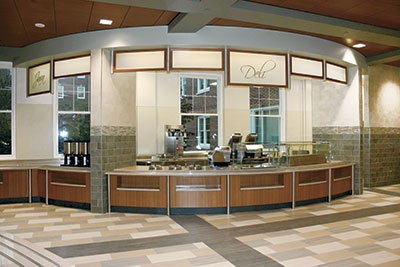 The Deli at Reading Hospital is one of several outposts that contributed to retail sales doubling since 2012-2013.The Reading Hospital café also includes a grill, handmade pizzas, a du jour hot bar, traditional grab-and-go items, beverages and a chef’s demonstration station. “In fall 2015, we launched Chefs Without Borders, an eclectic mix of healthier choices, including made-to-order pho and rice bowls and salads on a daily rotation,” Brennan says. Additionally in fall 2015, the dining department allocated more prominent space to the sushi station, which features fresh sushi five days a week. “No sushi platters are more than 24 hours old,” Brennan says.
The Deli at Reading Hospital is one of several outposts that contributed to retail sales doubling since 2012-2013.The Reading Hospital café also includes a grill, handmade pizzas, a du jour hot bar, traditional grab-and-go items, beverages and a chef’s demonstration station. “In fall 2015, we launched Chefs Without Borders, an eclectic mix of healthier choices, including made-to-order pho and rice bowls and salads on a daily rotation,” Brennan says. Additionally in fall 2015, the dining department allocated more prominent space to the sushi station, which features fresh sushi five days a week. “No sushi platters are more than 24 hours old,” Brennan says.
For promoting healthier food consumption, Reading continues to move toward replacing all purchased baked goods with items made from the in-house bakery. In partnership with the hospital’s exclusive beverage company, the cafeteria now offers brewed teas and unsweetened beverages and is moving away from offering beverages with artificial sweeteners. Rotated floor displays in easily accessible areas contain healthier alternatives during promotions for the Super Bowl, March Madness and other events.
In the Patio Grille, located in another Reading building, Chef Jennifer Noecker introduced healthier entrées and sides and also alternatives to “Berks County favorites.” The most popular menu items now have vegetarian or heart-healthy versions available. Patio Grille also features a special pop-up-style display station that offers healthier options.
Reading Hospital also promotes healthier eating by selling locally grown fruits and vegetables to employees at the nutrition services department’s cost. Located inside the employee cafeteria, Farm Stand is open from May through September.
To encourage healthful practices at UCLA Health System in Los Angeles, Patti Oliver, MS, RDN, MBA, director of nutrition, and her team completely eliminated fried food in the operations. The team also reduced the cost of purchasing food at the salad bar from $6.99 per pound to $4.99 per pound to encourage consumption of fruits and vegetables. The department features Meatless Mondays. All of the operation’s beef and 90 percent of its poultry is raised without the routine use of nontherapeutic antibiotics. Sixty-five percent of the produce is locally grown and/or organic. “We have a map in the cafeterias that shows how far all the produce has traveled to get here,” Oliver says. The team also sells reusable coffee mugs and gives a discount on coffee to anyone who brings in his or her own reusable mug. A few years ago, every UCLA employee received a reusable water bottle to use at hydration stations around campus. The team eliminated plastic bags in retail areas and sells reusable bags made from recycled material.
In Centennial, Colo., a new corporate dining center soon will open at Centura Health. “We’re merging our four corporate offices into one and will feature a café and offer catering in this new building,” says Lisa Poggas, MS, RD, director of nutrition and environmental services.
The café will seat 135 people and operate Monday through Friday from 7 a.m. until 5 p.m. A 500-square-foot kitchen will support dining and catering. “Administrators were so enamored with what Chef Daniel Skay, nutrition manager/executive chef at our Castle Rock Adventist hospital, has done at Manna, Castle Rock’s full-service restaurant, they realized that we were quite capable of providing great food for catering and meals at the new
Corporate Café. Chef Dan has mentored Doug Kastendieck, who will be the supervisor at the new café.”
The challenge for Poggas, Skay and all healthcare foodservice operators is how to continue offering creative, fresh, healthful meals at an affordable cost. Skay continues to bring value-added cost savings to the new spring/summer menu at Manna. “We’re using lesser cuts of meats or eliminating meats altogether,” Skay says. For example, a new menu item, smoky grilled cabbage steaks with hickory beef bacon and smoked Moody blue cheese, sells very well. Other new menu items meeting the value-added cost savings criteria include Feijoada Brazilian beef tips with masa cakes and cotija, organic polenta with smoked mushrooms and burrata, and mole-roasted carrot tacos, as well as smokehouse short ribs (a chuck tail flap for cost savings) that are barbecue-glazed with cheesy grits and served with charred radish tossed with bacon jam.
Another way the Centura system looks to cut costs is by standardizing the type of foods all 10 hospitals in the system can buy. Systems such as Intermountain Healthcare in Salt Lake City, Texas Health and HCA, as well as contract management companies, have taken this approach for years.
Seeking out local companies to provide food also contributes to quality improvement and, in some cases, cost savings. “We’ve forged relationships with a local company that provides healthy grab-and-go items such as burritos with quinoa, sweet potatoes and black beans,” Poggas says. Skay is working with a local bakery that works with adults with developmental disabilities.
 Castle Rock’s Manna restaurant features Chef Daniel Skay’s organic polenta with smoked mushrooms and burrata.To keep retail customer satisfaction high, at Parker Adventist Hospital and Castle Rock Adventist Hospital, Poggas’ team expands the menu’s side dishes so customers have many options. “We don’t have a fryer, but I would love to bring it back,” Poggas admits. Her operations offer many healthy sides, such as quinoa salad, couscous, roasted vegetables and roasted potato dishes.
Castle Rock’s Manna restaurant features Chef Daniel Skay’s organic polenta with smoked mushrooms and burrata.To keep retail customer satisfaction high, at Parker Adventist Hospital and Castle Rock Adventist Hospital, Poggas’ team expands the menu’s side dishes so customers have many options. “We don’t have a fryer, but I would love to bring it back,” Poggas admits. Her operations offer many healthy sides, such as quinoa salad, couscous, roasted vegetables and roasted potato dishes.
Offering special menu items such as gluten-free options is a necessity at Parker — and at all hospitals. The challenge facing culinary teams is explaining to customers why the prices must be higher for special items. When prices are not adjusted, foodservice departments must absorb the extra costs.
Wellness extends to the community as hospitals become centers for preventive care as well as facilities to treat the sick. For example, Chester County Hospital offers the Healthy Neighbor Supper Club, a service developed in collaboration with the Chester County Community Wellness team that focuses on the elderly in the local community by offering lectures on health topics and a reduced-price meal in the hospital café. “This has turned into a social event for many seniors in the area,” Greenley says. “We often see 25 or more seniors every Thursday evening.”
As directors and their teams continue to find creative solutions to all these enormous challenges, they will be watching carefully to identify the many game changers that will influence how they operate their foodservice departments. Staying at the top of whichever game is played will no doubt test their acumen, patience and perseverance.
Addressing Labor Shortages and Retention
Finding qualified employees at all skill levels and providing adequate training for development has long been the most daunting challenge for operators in all foodservice channels. This scenario isn't rare: What is an operator to do after spending weeks carefully hiring a chef who, within a month of arriving, declares that she won't work weekends or late nights? After some negotiation, she texts in her resignation. Whatever the situation, operators must now be more creative than ever to attract qualified employees. In markets where unemployment rates remain low, workforce shortages are forcing employers to turn their attention to employee retention.
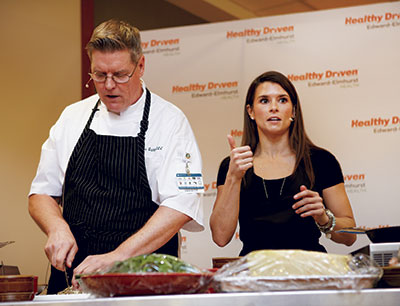 Race car driver Danica Patrick and Executive Chef Jim Roth give a cooking demo in the Wildflower Café at Edward-Elmhurst Health.At Edward-Elmhurst Health in Elmhurst, Ill., for example, employee retention is a priority. "There's a different dynamic to continuously work on improving employees' performance and also retain them," says Dave Reeves, director of hospitality services. "The labor pool for entry-level candidates is competitive, and we find it challenging to recruit enough qualified candidates for job openings. To complicate matters further, this facility is located in a western suburb near the Chicago city border, where a phased increase of the minimum wage is rising to $13 an hour by 2019, so employees have more choices of places to work to earn those wages."
Race car driver Danica Patrick and Executive Chef Jim Roth give a cooking demo in the Wildflower Café at Edward-Elmhurst Health.At Edward-Elmhurst Health in Elmhurst, Ill., for example, employee retention is a priority. "There's a different dynamic to continuously work on improving employees' performance and also retain them," says Dave Reeves, director of hospitality services. "The labor pool for entry-level candidates is competitive, and we find it challenging to recruit enough qualified candidates for job openings. To complicate matters further, this facility is located in a western suburb near the Chicago city border, where a phased increase of the minimum wage is rising to $13 an hour by 2019, so employees have more choices of places to work to earn those wages."
Edward-Elmhurst Health's efforts to retain employees began with a baseline engagement survey to identify its strengths and weaknesses. "Pay is important to hospitality employees," Reeves says, "but an individual's relationship with his or her boss is the key to job satisfaction. We know that if an employee has a good relationship with their direct supervisor that engagement is higher. So we focus on rewards and basic management principles, which unfortunately can inadvertently take lower priority in the midst of major projects and computer upgrades."
One of the most promising approaches is the adoption of a culture identified by values of determination, respect, integrity, vision, excellence and nurturing, which come together to form the acronym DRIVEN. "The Healthy Driven idea was the result of an in-depth study and interview process we did with an advertising agency and with health system leadership," Reeves says. "We were looking for a brand that truly embodies who we are as a new health system and captures what differentiates us from our competitors. Healthy Driven was born out of that. It's consumer-focused and represents our commitment to moving the health of our community forward, wherever they are in their lives."
Continuous employee recognition is part of the value system. For instance, anyone in a management or leadership position carries "Caught You Being DRIVEN" business-sized cards. "When we see someone we want to recognize, we pull out a card, write the person's name on it with a handwritten note and give the card to the employee," Reeves says. Managers are now encouraged to utilize this recognition as a consideration when nominating staff for the Healthy Driven Hero Recognition Program.
The 2013 launch of the Healthy Driven wellness campaign to encourage Chicago-area residents to live healthier lifestyles coincided with the merger of Edward, Linden Oaks and Elmhurst Memorial hospitals. To kick off the campaign, the hospital brought in professional race car driver Danica Patrick as a spokesperson. Ads featuring Patrick popped up on TV and radio, in newspapers and magazines, and on billboards and public transit signage. In addition, an online campaign called the Danica Patrick Healthy Driven Challenge allowed people to select from several challenges to improve their health.
"Danica is strong, approachable, with an intense desire to succeed," Reeves says. "And as a woman succeeding in a male-dominated sport, she's a true trailblazer, just like Edward-Elmhurst Health." Passionate about food and healthy eating, Patrick worked alongside Executive Chef Jim Roth to do a cooking demonstration in the Wildflower Café.
In the midst of workforce shortages, Reeves and his team also reexamine workforce schedules. "Managers have become creative scheduling experts," he says. "Managers and chefs fill in as needed while we hire and train new people for jobs. We've tried not to compromise the integrity of our operations." Limited transactions caused Reeves and his team to recently eliminate staffed foodservice on the midnight shift. The alternative service features a dispenser constructed of recycled materials that attractively displays fresh fruits and salads and functions similarly to a vending machine. Customers select items they want on the electronic menu board and make purchases by credit card.
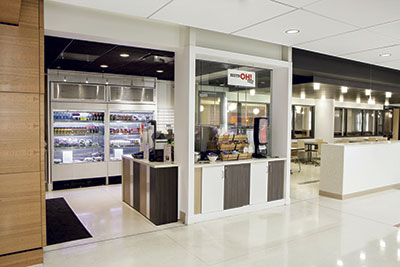 BistrOH! to Go at The Ohio State University Wexner Medical Center offers food from 10:30 p.m. until 1 p.m.Workforce initiatives also receive priority at The Ohio State University Wexner Medical Center in Columbus. "We have a very tight labor market," says Julie Jones, MS, RD, LD, director of nutrition services. "We want retail programs to support work-life balance. We've done a lot of work to meet their needs. College and university students are now our employees, and they expect what they got while they were in college."
BistrOH! to Go at The Ohio State University Wexner Medical Center offers food from 10:30 p.m. until 1 p.m.Workforce initiatives also receive priority at The Ohio State University Wexner Medical Center in Columbus. "We have a very tight labor market," says Julie Jones, MS, RD, LD, director of nutrition services. "We want retail programs to support work-life balance. We've done a lot of work to meet their needs. College and university students are now our employees, and they expect what they got while they were in college."
Jones and her team recently revived an employee takeout program that offers packaged meals, bulk soups and menu items such as mac and cheese. They pick their orders up in the cafés. "Our cook-chill production allows us to offer menu items for home meal delivery that we couldn't do before," Jones says.
In addition, a grab-and-go operation at BistrOH! to Go, which sits on a very busy concourse, offers food from 10:30 p.m. until 1 p.m. to support the night through lunch meal period. Only one employee is needed to work there. High-speed ovens allow the menu to include hot sandwiches. "We don't have much vending, so this replaces that option," Jones says.
Sustainable Practices
Sustainable practices and interest continue to blossom in healthcare facilities — and foodservice in particular.
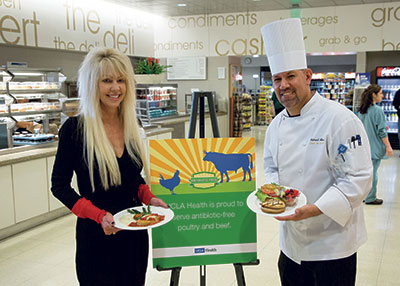 UCLA Health System’s Patti Oliver and Executive Chef Gabriel Gomez show off dishes made with antibiotic-free proteins."We are in progress toward zero waste to landfill by 2020, and currently 70 percent of disposables used throughout the foodservice program are compostable, 20 percent are recyclable and only 10 percent go to landfills," says Patti Oliver, MS, RDN, MBA, director of nutrition, UCLA Health System in Los Angeles. The hospitals' pre-consumable and post-consumable disposables are sorted as recyclable, compostable, or landfill-bound and disposed of accordingly. Areas located in the cafeterias contain separate bins for each, with illustrations that show customers which items go in which bins.
UCLA Health System’s Patti Oliver and Executive Chef Gabriel Gomez show off dishes made with antibiotic-free proteins."We are in progress toward zero waste to landfill by 2020, and currently 70 percent of disposables used throughout the foodservice program are compostable, 20 percent are recyclable and only 10 percent go to landfills," says Patti Oliver, MS, RDN, MBA, director of nutrition, UCLA Health System in Los Angeles. The hospitals' pre-consumable and post-consumable disposables are sorted as recyclable, compostable, or landfill-bound and disposed of accordingly. Areas located in the cafeterias contain separate bins for each, with illustrations that show customers which items go in which bins.
These practices have resulted in UCLA Health receiving several awards, including the 2016 Sustainability Quality Grand Prize Award from the City of Santa Monica and the Santa Monica Chamber of Commerce.
Another facet of a facility's sustainability that must be addressed is emergency preparedness. "All foodservices must take into consideration emergency preparedness," says foodservice consultant Betty Perez, RD, DHCFA, of Suffern, N.Y., who worked at NYU Langone Medical Center, which incurred serious damage during Hurricane Sandy. "You must consider where your kitchen is being positioned. In retail venues, you must have the right equipment so you can support patient feeding if necessary."



